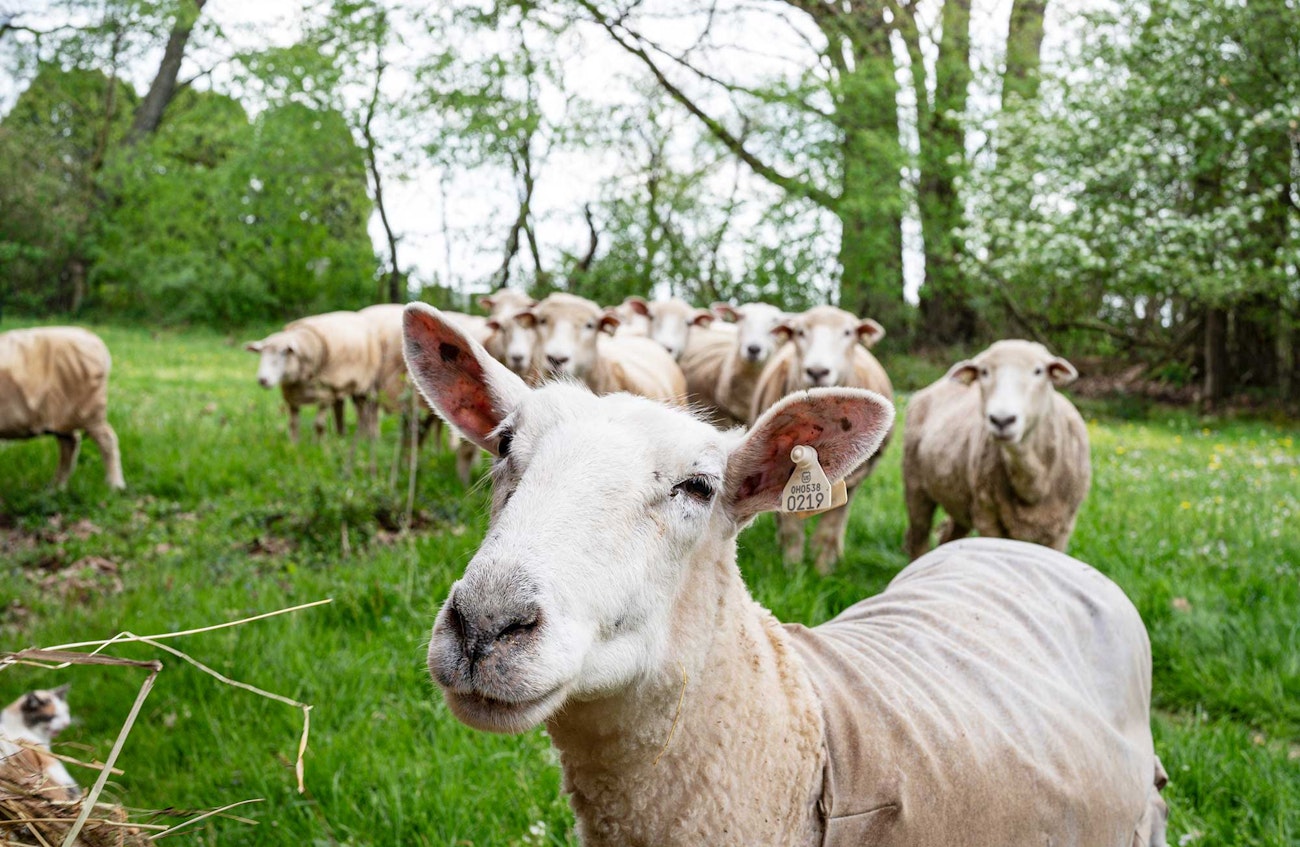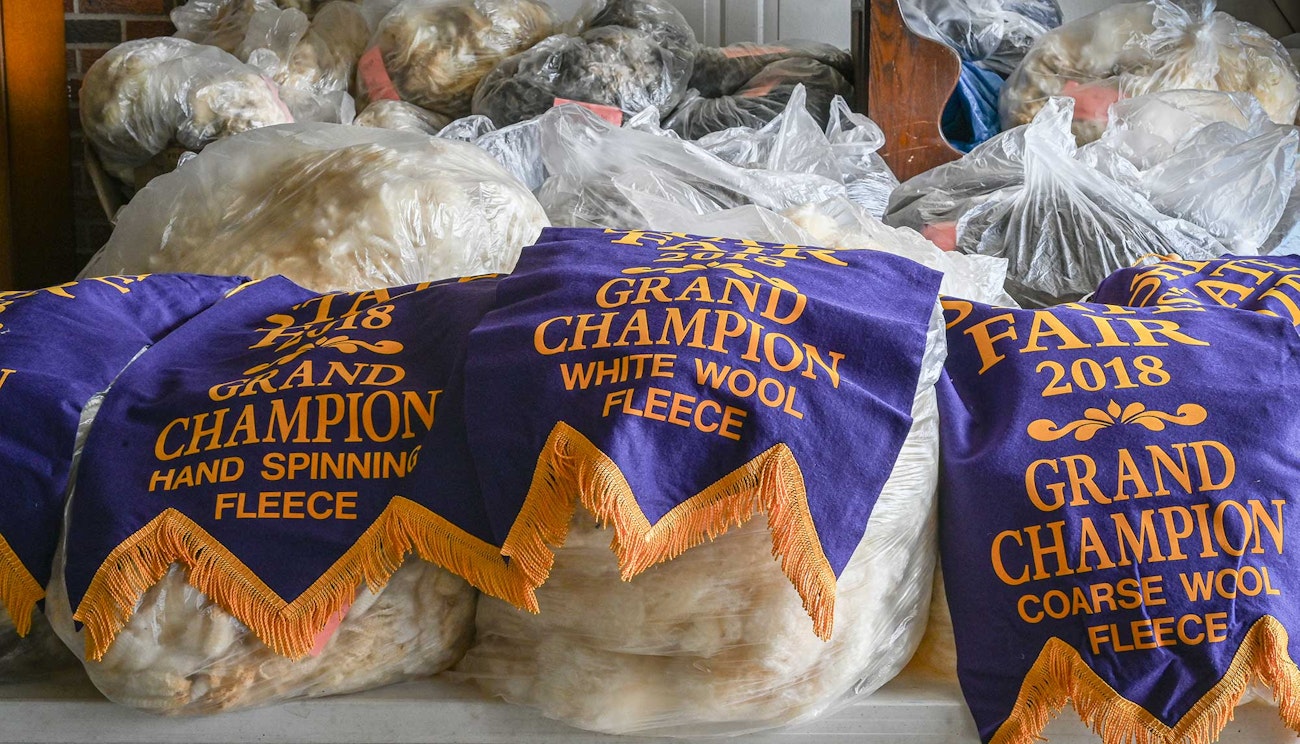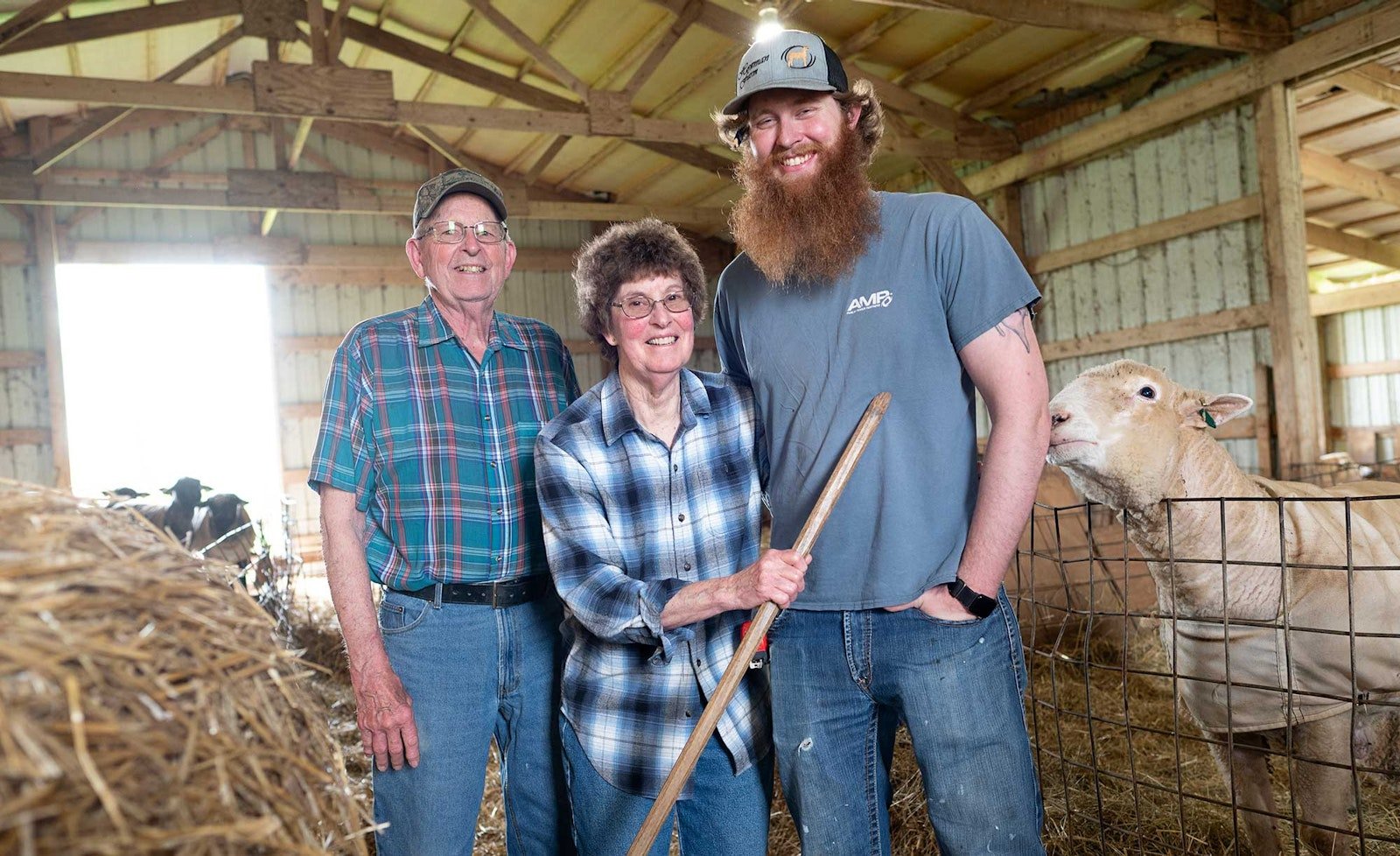Subscriber Exclusive
Field Trip: How to Make a Farm Yarn? Go Straight to the Pasture.
A LYS owner headed straight to the source when creating a small-batch yarn, and she found so much more.
A LYS owner headed straight to the source when creating a small-batch yarn, and she found so much more. <a href="https://farmfiberknits.com/how-to-make-farm-yarn-straight-from-the-pasture/">Continue reading.</a>
https://farmfiberknits.com/cdn-cgi/image/format=auto/https://www.datocms-assets.com/101500/1730914052-reichert-farm-header-2.jpg?auto=format&w=900
Linda and Don Reichert with their grandson, Austin, on their farm in Wooster, Ohio. Photos by Gale Zucker
On a warm spring Sunday, I headed to rural Ohio for a farm field trip with local yarn store owner and farm-yarn evangelist Andrea Panzica. Andrea was looking forward to a reunion with shepherds Don and Linda Reichert, and we would be picking up a 100-pound truckload of fleece for Andrea’s newest yarn line. Andrea first connected with the Reicherts through their fiber, but they soon became treasured friends. In addition to raising their own flock near Wooster, Ohio, the Reicherts organized the Great Lakes Fiber Show for many years. The event grew into one of the largest fiber events in the region, supporting a vibrant community of makers.
Making Connections
Andrea’s relationship with the Reicherts began when she wanted to create her own locally sourced yarn to sell at 614 Knit Studio, her shop in Columbus, Ohio. Logically, Andrea headed to the Ohio State Fair, where she made a beeline for the sheep barn and bought that year’s ribbon-winning fleeces. She also attended the Great Lakes Fiber Show and scooped up the Best of Show fleeces. As it turned out, the meticulously skirted wool Andrea bought at both festivals came from the same source: Don and Linda Reichert. Andrea learned that the Reicherts were also legendary repeat prize winners at the Maryland Sheep & Wool Festival, where their Corriedale and Border Leicester fleeces were beloved by handspinners. The Reicherts’ farm was only a 90-minute drive from Andrea’s home, so she reached out to the couple to schedule a visit—which turned into multiple visits and generated a growing friendship.
Get a closer look! Click any image to open it in full-screen mode and read more about Andrea’s fleece haul.
Andrea’s frequent visits to the farm acquainted her with both sheep and shepherds. She learned of the challenge small farms have in clearing out their wool clip each year. When she decided to create a new yarn, she went straight to the Reicherts for 100 pounds of fleece. The result, which Andrea named Pride of Ohio, was a wonderfully lustrous sportweight yarn in two natural colors from Don and Linda’s Corriedale and Border Leicester sheep. A small amount was also blended with alpaca to create an Aran-weight three-ply yarn.
 Sheep grazing at Don and Linda Reichert’s farm in Wooster, Ohio
Sheep grazing at Don and Linda Reichert’s farm in Wooster, Ohio
Don and Linda Reichert started raising sheep on their five-acre farm as part of a 4-H project with their children in the early 1980s. Meat and wool were equally important to the family—that is, until Linda became immersed in handspinning. The more Linda spun, the more the Reicherts specialized in producing the finest fleeces. By the mid-1980s, the Reicherts were running the Great Lakes Fiber Show. The event began as a few vendor tables alongside a well-established sheep show, and it grew into a large regional festival with 100 vendors, workshops, competitions, and more. They retired from the show in 2016, but the event continues to connect fiber producers with knitters, spinners, and more.
Get a closer look! Click any image to open it in full-screen mode and learn more about the Reicherts’ sheep.
Don and Linda continue to produce prizewinning fleeces year after year from the Corriedales they raise, which are mostly white. As time passed and their family grew, the shepherding gene passed over the Reicherts’ daughters but landed squarely on their grandchildren. Their granddaughter
SUBSCRIBER EXCLUSIVE
Unlock the Full Article with a Farm & Fiber Knits Subscription
Get instant access to this article and the entire Farm & Fiber Knits library of projects, inspiration, and expert instruction. With your subscription, you’ll receive:
Connect more deeply with your yarn—learn the stories of farmers, shepherds, and dyers
Knit patterns that celebrate natural fibers and slow, intentional making
Support a community of small farms, women makers, and independent yarn companies
Includes print and digital issues of Farm & Fiber Knits, delivered directly to you
With must-knit projects and unforgettable stories, Farm & Fiber Knits invites you to see the craft world through fresh eyes.
Plans start at just $5.83/month (paid annually). Cancel anytime.
On a warm spring Sunday, I headed to rural Ohio for a farm field trip with local yarn store owner and farm-yarn evangelist Andrea Panzica. Andrea was looking forward to a reunion with shepherds Don and Linda Reichert, and we would be picking up a 100-pound truckload of fleece for Andrea’s newest yarn line. Andrea first connected with the Reicherts through their fiber, but they soon became treasured friends. In addition to raising their own flock near Wooster, Ohio, the Reicherts organized the Great Lakes Fiber Show for many years. The event grew into one of the largest fiber events in the region, supporting a vibrant community of makers.
Making Connections
Andrea’s relationship with the Reicherts began when she wanted to create her own locally sourced yarn to sell at 614 Knit Studio, her shop in Columbus, Ohio. Logically, Andrea headed to the Ohio State Fair, where she made a beeline for the sheep barn and bought that year’s ribbon-winning fleeces. She also attended the Great Lakes Fiber Show and scooped up the Best of Show fleeces. As it turned out, the meticulously skirted wool Andrea bought at both festivals came from the same source: Don and Linda Reichert. Andrea learned that the Reicherts were also legendary repeat prize winners at the Maryland Sheep & Wool Festival, where their Corriedale and Border Leicester fleeces were beloved by handspinners. The Reicherts’ farm was only a 90-minute drive from Andrea’s home, so she reached out to the couple to schedule a visit—which turned into multiple visits and generated a growing friendship.
Get a closer look! Click any image to open it in full-screen mode and read more about Andrea’s fleece haul.
Andrea’s frequent visits to the farm acquainted her with both sheep and shepherds. She learned of the challenge small farms have in clearing out their wool clip each year. When she decided to create a new yarn, she went straight to the Reicherts for 100 pounds of fleece. The result, which Andrea named Pride of Ohio, was a wonderfully lustrous sportweight yarn in two natural colors from Don and Linda’s Corriedale and Border Leicester sheep. A small amount was also blended with alpaca to create an Aran-weight three-ply yarn.
 Sheep grazing at Don and Linda Reichert’s farm in Wooster, Ohio
Sheep grazing at Don and Linda Reichert’s farm in Wooster, Ohio
Don and Linda Reichert started raising sheep on their five-acre farm as part of a 4-H project with their children in the early 1980s. Meat and wool were equally important to the family—that is, until Linda became immersed in handspinning. The more Linda spun, the more the Reicherts specialized in producing the finest fleeces. By the mid-1980s, the Reicherts were running the Great Lakes Fiber Show. The event began as a few vendor tables alongside a well-established sheep show, and it grew into a large regional festival with 100 vendors, workshops, competitions, and more. They retired from the show in 2016, but the event continues to connect fiber producers with knitters, spinners, and more.
Get a closer look! Click any image to open it in full-screen mode and learn more about the Reicherts’ sheep.
Don and Linda continue to produce prizewinning fleeces year after year from the Corriedales they raise, which are mostly white. As time passed and their family grew, the shepherding gene passed over the Reicherts’ daughters but landed squarely on their grandchildren. Their granddaughter[PAYWALL] Taylor keeps her Border Leicester sheep at the farm, and their grandson Austin has moved to the adjacent property to raise his Corriedale flock in his grandparents’ barn and share their grazing space.
 Some of the dozens of ribbons, awards, and banners Linda and Don Reichert have received for their sheep and fleeces.
Some of the dozens of ribbons, awards, and banners Linda and Don Reichert have received for their sheep and fleeces.
With a little coaxing during our visit, I persuaded Don to bring out some of the dozens of prize banners and ribbons he and Linda have won over the years. Don and Linda continue to attend fiber shows but no longer compete. As Don pointed out, they have no incentive—their fleeces are spoken for before the shows open!
Get a closer look! Click any image to open it in full-screen mode and read more about Andrea’s yarn, spun from the Reicherts’ fleeces.
 Andrea Panzica and Sarah Barca pose after loading 100 pounds of 2024 Corriedale fleece from the Reicherts to bring home for spinning and dyeing. This clip was later blended with yarn from the Battenkill Fiber Mill wool pool in upstate NY and spun as a heavy DK weight. The resulting skeins were named Studio Dog Fibers Farmstead DK, to be released in early 2025, in natural shades and dyed.
Andrea Panzica and Sarah Barca pose after loading 100 pounds of 2024 Corriedale fleece from the Reicherts to bring home for spinning and dyeing. This clip was later blended with yarn from the Battenkill Fiber Mill wool pool in upstate NY and spun as a heavy DK weight. The resulting skeins were named Studio Dog Fibers Farmstead DK, to be released in early 2025, in natural shades and dyed.
 Studio Dog Fibers’ Annie & Finn yarn, spun from the Reicherts’ Corriedale sheep blended with Finn, 60/40. Available from 614 Knit Studio in Columbus, Ohio.
Studio Dog Fibers’ Annie & Finn yarn, spun from the Reicherts’ Corriedale sheep blended with Finn, 60/40. Available from 614 Knit Studio in Columbus, Ohio.
 Handknitted hat from two natural colors of Studio Dog Fibers’ Pride of Ohio yarn, shown with some of the source sheep in the background at Don and Linda Reichert’s farm in Wooster, Ohio. Pattern is Sacred Sheep Hat from Caitlin Hunter/Boyland Knitworks, available from Ravelry. Yarn is available from 614 Knit Studio in Columbus, Ohio.
Handknitted hat from two natural colors of Studio Dog Fibers’ Pride of Ohio yarn, shown with some of the source sheep in the background at Don and Linda Reichert’s farm in Wooster, Ohio. Pattern is Sacred Sheep Hat from Caitlin Hunter/Boyland Knitworks, available from Ravelry. Yarn is available from 614 Knit Studio in Columbus, Ohio.
 Handknitted wrap in Studio Dog Fibers’ Corriedale/alpaca Aran-weight blend, shown with contributing sheep in the background. Pattern is Woven Studio Wrap by Sarah Barca/Strung Out Knits, available from Ravelry. Yarn is from 614 Knit Studio in Columbus, Ohio.
Handknitted wrap in Studio Dog Fibers’ Corriedale/alpaca Aran-weight blend, shown with contributing sheep in the background. Pattern is Woven Studio Wrap by Sarah Barca/Strung Out Knits, available from Ravelry. Yarn is from 614 Knit Studio in Columbus, Ohio.
By the end of my visit with the Reicherts, I see they’ve won far more than award ribbons over the years. The real top prizes include warm friendships that go well beyond fiber and grandchildren who share their love for sheep farming and are committed to continuing the family farm tradition.
Gale Zucker is a commercial and editorial photographer with a specialty in wool and handmade items. As a lifelong knitter, she is thrilled to combine that passion with her profession. When not working, she can be found swimming or knitting in her Connecticut beach neighborhood.
 Sheep grazing at Don and Linda Reichert’s farm in Wooster, Ohio
Sheep grazing at Don and Linda Reichert’s farm in Wooster, Ohio 







 Some of the dozens of ribbons, awards, and banners Linda and Don Reichert have received for their sheep and fleeces.
Some of the dozens of ribbons, awards, and banners Linda and Don Reichert have received for their sheep and fleeces. 


